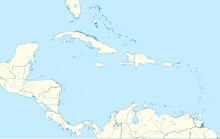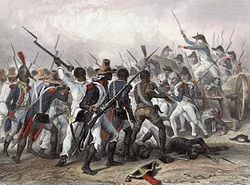Montserrat slave rebellion of 1768
Enslaved Africans |  Montserratian slaveowners Montserratian slaveowners |
Cudjoe 


| Part of a series on |
| North American slave revolts |
|---|
 Attack and capture of the Crête-à-Pierrot (Combat et prise de la Crête-à-Pierrot, March 1802) in the Haitian Revolution by Auguste Raffet, engraving by Ernest Hébert |
| Context
|
| Before 1700 (Spanish Florida, victorious)
(Real Audiencia of Panama, New Spain, suppressed)
(Veracruz, New Spain, victorious)
(New Spain, suppressed)
(New Spain, suppressed)
|
| 18th century (British Province of New York, suppressed)
(British Jamaica, victorious)
(British Chesapeake Colonies, suppressed)
(Louisiana, New France, suppressed) (Danish Saint John, suppressed)
(British Province of South Carolina, suppressed)
(British Province of New York, suppressed)
(British Jamaica, suppressed)
(British Montserrat, suppressed)
(British Bahamas, suppressed)
(Louisiana, New Spain, suppressed) (Louisiana, New Spain, suppressed) (Dutch Curaçao, suppressed)
|
| 19th century
(Virginia, suppressed)
(St. Simons Island, Georgia, victorious)
(Virginia, suppressed) (Territory of Orleans, suppressed)
(Spanish Cuba, suppressed)
(Virginia, suppressed)
(British Barbados, suppressed)
(South Carolina, suppressed)
(Cuba, suppressed) (Virginia, suppressed)
(British Jamaica, suppressed)
(off the Cuban coast, victorious)
(off the Southern U.S. coast, victorious) (Indian Territory, suppressed)
(Spanish Cuba, suppressed) (South Carolina, suppressed)
|
| Notable leaders |
|
The Montserrat slave rebellion of 1768 was an unsuccessful slave rebellion in the English colony of Montserrat in the Caribbean Sea that took place on 17 March 1768.
Background
Anglo-Irish planters began to settle Montserrat in the 1630s following tensions with the British in nearby St Kitts[1] and started importing African slaves in 1650 to work on the island's cotton, tobacco, and sugarcane plantations.[2] By the late 1760s, as a result of dwindling provisions, labour shortages, and increasingly strict oversight, slaves faced worsening living conditions.[3]
Uprising
By 1768, slaves outnumbered white colonialists by three to one,[1] and black and creole Montserratians, led by the slave Cudjoe, decided to stage an uprising against the plantation owners.[3] 17 March was chosen as the day of the uprising as the rebels knew that their masters would be drinking heavily for St Patrick's Day.[4]
The rebels planned for domestic slaves at Government House to seize any weapons held there[5] while other slaves would arm themselves with rocks, farm tools, clubs and homemade swords,[1] but the plot was disclosed by a female slave,[6] leading to a successful quashing of the rebellion.
Repercussions
Nine rebels, including Cudjoe, were hanged,[4] and his head placed on a silk-cotton tree as a warning to slaves considering another revolt.[5] Thirty other rebels were imprisoned and then sold to other islands.[5]
Cultural legacy
The uprising was forgotten until 1971 when Montserratian scholars discovered references to the rebellion and began to publicise it. In 1985, the Government of Montserrat declared 17 March a national holiday.[5] St Patrick's Day is now the centrepoint of a ten day festival honouring the rebellion and its members.[4]
In 2018, Montserratian playwright Chadd Cumberbatch wrote and directed a new play, 1768, as a theatrical re-imagining of the uprising to mark the 250th anniversary of the events.[7][8]
References
- ^ a b c Afrikan77, New (17 March 2018). "The Cudjoe & Montserrat Slave Rebellion March 17 1768 Africans Attack Irish Planters". newafrikan77. Retrieved 23 March 2022.
{{cite web}}: CS1 maint: numeric names: authors list (link) - ^ Lennard, J. (1998) "Grumblings from an Ashen Island", Americas, Vol. 50, Issue 1, p. 44.
- ^ a b Ryzewski & Cherry, p. 356.
- ^ a b c Meade, Natalie (21 March 2019). "St Patrick's Day on Montserrat". The New Yorker. Conde Nast. Retrieved 1 September 2021.
- ^ a b c d Fergus, p. 83.
- ^ Bush, p. 67.
- ^ "1768: A Theatric Reimagining of St. Patrick's Day 250 Years Ago". 20 March 2018.
- ^ "1768 Uprising to be remembered with Drums at Montserrat's St Patrick's Festival".
Sources
- Bush, B. (1990) Slave Women in Caribbean Society 1650-1838, Heinemann Publishers: Kingston, Jamaica. ISBN 085255 058 8.
- Fergus, H. (1996) Gallery Montserrat: Some Prominent People In Our History, Canoe Press, Montserrat. ISBN 976-8125-25-X.
- Ryzewski, K. & Cherry, J. (2015) "Struggles of a Sugar Society: Surveying Plantation-Era Montserrat, 1650–1850", International Journal of Historical Archeology, 19 (2).











